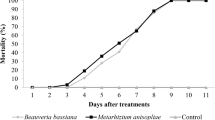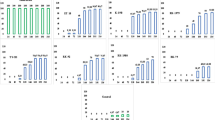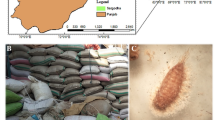Abstract
The knowledge of the interactions between endophytic entomopathogenic fungi and forage plants and their influence on Spodoptera frugiperda, an emerging pest of pastoral systems, is important to elucidate the multifunctionality of these microorganisms and their benefits to agroecosystems. This study investigated the influence of endophytic colonization with different isolates of Metarhizium anisopliae on Cynodon dactylon (L.) Pers (Poaceae) cv. Tifton 85 on biological and behavioral aspects of S. frugiperda. The application of a suspension of isolates (1 × 108 conidia ml−1) to the base (soil drench) of C. dactylon seedlings was effective to promote endophytic colonization. Spodoptera frugiperda caterpillars fed throughout their larval stage with leaves of plants colonized endophytically by the three isolates studied (CEPAF_ENT 25, CEPAF_ENT 27, and IBCB 425) of M. anisopliae showed considerable reduction in their biological performance, especially in parameters of their fertility life table. However, the tested isolates did not show pronounced effects on feeding and oviposition preference, although there was a trend of preference of caterpillars and moths for colonized plants, especially in no-choice tests. Thus, applications of mycoinsecticides based on M. anisopliae for the management of the spittlebug complex (its main use currently) may lead to the endophytic colonization of C. dactylon cv. Tifton 85 and influence S. frugiperda population density as well as the impact this pest causes to pastures. The isolates used in this study exhibit multiple spectrums of action and potential to produce new biological products for the market.



Similar content being viewed by others
Data availability
Not applicable.
Code availability
Not applicable.
References
Agrofit (2022) Sistema de agrotóxicos fitossanitários. Ministério da Agricultura, Pecúaria e Abastecimento. http://agrofit.agricultura.gov.br/agrofit_cons/principal_agrofit_cons. Accessed 25 Oct 2022
Ahmad I, Jiménez-Gasco MM, Luthe DS, Shakeel SN, Barbercheck ME (2020) Endophytic Metarhizium robertsii promotes maize growth, suppresses insect growth, and alters plant defense gene expression. Biocontrol 144:104–167
Allegrucci N, Velazquez MS, Russo ML, Perez E, Scorsetti AC (2017) Endophytic colonisation of tomato by the entomopathogenic fungus Beauveria bassiana: The use of different inoculation techniques and their effects on the tomato leafminer Tuta absoluta (Lepidoptera: Gelechiidae). J Plant Prot Res 57:331–337
Behie SW, Moreira CC, Sementchoukova I, Barelli L, Zelisko PM, Bidochka MJ (2017) Carbon translocation from a plant to an insect-pathogenic endophytic fungus. Nat Commun 8:142–145
Bischoff JF, Rehner SA, Humber RA (2009) A multilocus phylogeny of the Metarhizium anisopliae lineage. Mycologia 101:512–530
Boaventura D, Martin M, Pozzebon A, Mota-Sanchez D, Nauen R (2020) Monitoring of target-site mutations conferring insecticide resistance in Spodoptera frugiperda. Insects 11:545
Brunner-Mendoza C, Reyes-Montes MR, Moonjely S, Bidochka MJ, Toriello C (2018) A review on the genus Metarhizium as an entomopathogenic microbial biocontrol agent with emphasis on its use and utility in Mexico. Biocontrol Sci Technol 29:83–102. https://doi.org/10.1080/09583157.2018.1531111
Canassa F, D’Alessandro CP, Sousa SB, Demétrio CGB, Meyling NV, Klingen I, Delalibera I (2020) Fungal isolate and crop cultivar influence the beneficial effects of root inoculation with entomopathogenic fungi in strawberry. Pest Manag Sci 76:1472–1482
Carvalho RA, Omoto C, Field LM, Williamson MS, Bass C (2013) Investigating the molecular mechanisms of organophosphate and pyrethroid resistance in the fall armyworm Spodoptera frugiperda. PLoS ONE 8:262–268
Castillo-Lopez D, Zhu-Salzman K, Ek-Ramos MJ, Sword GA (2014) The entomopathogenic fungal endophytes Purpureocillium lilacinum (formerly Paecilomyces lilacinus) and Beauveria bassiana negatively affect cotton aphid reproduction under both greenhouse and field conditions. PLoS ONE 9:53–61
Chiaradia LA, Miranda M, Fedatto VJJ (2013) Flutuação populacional de cigarrinhas-das-pastagens na grama-missioneira-gigante. Agrop Catarinense 26:70–75
Cruz IA (1995) Lagarta-do-cartucho na cultura do milho. Embrapa 21:5–6
De Lira AC, Mascarin GM, Delalibera Júnior Í (2020) Microsclerotia production of Metarhizium spp. for dual role as plant biostimulant and control of Spodoptera frugiperda through corn seed coating. Fungal Biol 124:689–699
Driver F, Milner RJ, Trueman JWH (2000) A taxonomic revision of Metarhizium based on a phylogenetic analysis of rDNA sequence data. Mycol Res 104:134–150. https://doi.org/10.1017/s0953756299001756
Ebora RV, Ebora MM, Sticklen MU (1994) Transgenic potato expressing the Bacillus thuringiensis CryIA(c) gene effects on the survival and food consumption of Phthorimea operculella (Lepidoptera: Gelechiidae) and Ostrinia nubilalis (Lepidoptera). J Econ Entomol 87:1122–1127
EPPO (2022) EPPO Global Database. Available online: http://gd.eppo.int. Accessed 10 Jan 2022
Fan J, Wu P, Tian T, Ren Q, Haseeb M, Zhang R (2020) Potential distribution and niche differentiation of Spodoptera frugiperda in Africa. Insects 11:383
Flonc B, Barbercheck M, Ahmad I (2021) Observations on the relationships between endophytic Metarhizium robertsii, Spodoptera frugiperda (Lepidoptera: Noctuidae), and maize. Pathogens 10:713
Garrido-Jurado I, Resquín-Romero G, Amarilla SP, Ríos-Moreno A, Carrasco L, Quesada-Moraga E (2017) Transient endophytic colonization of melon plants by entomopathogenic fungi after foliar application for the control of Bemisia tabaci Gennadius (Hemiptera: Aleyrodidae). J Pest Sci 90:319–330
Garrido-Jurado I, Montes-Moreno D, Sanz-Barrionuevo P, Quesada-Moraga E (2020) Delving into the causes and effects of entomopathogenic endophytic Metarhizium brunneum foliar application-related mortality in Spodoptera littoralis larvae. Insects 11:429
Golo PS, Gardner DR, Grilley MM, Takemoto JY, Krasnoff SB, Pires MS, Roberts DW (2014) Production of destruxins from Metarhizium spp. fungi in artificial medium and in endophytically colonized cowpea plants. PLoS One 9(8):e104946. https://doi.org/10.1371/journal.pone.0104946
Greene GL, Leppla NC, Dickerson WA (1976) Velvetbean caterpillar: a rearing procedure and artificial medium. J Econ Entomol 69:487–488
Hinde J, Demétrio CGB (1998) Overdispersion: models and estimation. Comput Stat Data Anal 27:151–170
Jaber LR, Ownley BH (2018) Can we use entomopathogenic fungi as endophytes for dual biological control of insect pests and plant pathogens? Biol Control 116:36–45
Kamaraj C, Gandhi PR, Elango G, Karthi S, Chung IM, Rajakumar G (2018) Novel and environmental friendly approach; Impact of neem (Azadirachta indica) gum nano formulation (NGNF) on Helicoverpa armigera (Hub.) and Spodoptera litura (Fab.). Int J Biol Macromol 107:59–69
Kepler RM, Rehner SA (2013) Genome-assisted development of nuclear intergenic sequence markers for entomopathogenic fungi of the Metarhizium anisopliae species complex. Mol Ecol Res 13:210–217
Kuchár M, Glare TR, Hampton JG, Dickie IA, Christey MC (2019) Virulence of the plant-associated endophytic fungus Lecanicillium muscarium to diamondback moth larvae. New Zealand Plant Prot 72:253–259
Kumar S, Stecher G, Li M, Knyaz C, Tamura K (2018) MEGA X: Molecular evolutionary genetics analysis across computing platforms F. U. Battistuzzi (Ed). Mol Biol Evol 35:1547–1549
Liu T, Wang J, Hu X, Feng J (2020) Land-use change drives present and future distributions of fall armyworm, Spodoptera frugiperda (JE Smith) (Lepidoptera: Noctuidae). Sci Total Environ 706:135872
Lohmann TR, Pietrowski V, Bressan DF (2010) Flutuação populacional de cigarrinhas-das-pastagens na região Oeste do Paraná. Semina 31:1291–1298
Lovatto M, Ribeiro LP (2017) Manejo das cigarrinhas-das-pastagens com fungos entomopatogênicos. Agrop Catarinense 30:42–46
Mahmoud FM, Bendebbah R, Benssaci B, Toudji F, Tafifet L, Krimi Z (2021) Entomopathogenic efficacy of the endophytic fungi: Clonostachys sp. and Beauveria bassiana on Tuta absoluta (Meyrick) (Lepidoptera: Gelechiidae) larvae under laboratory and greenhouse conditions. Egyptian J Biol Pest Control 31:e43
Maia HNM, Luiz AJB, Campanhola C (2000) Statistical inference on associated fertility life table parameters using jackknife technique: computational aspects. JEcon Entomol 93:511–518
Mantzoukas S, Eliopoulos PA (2020) Endophytic entomopathogenic fungi: A valuable biological control tool against plant pests. Appl Sci 10:360
Mantzoukas S, Kitsiou F, Natsiopoulos D, Eliopoulos P (2022) Entomopathogenic fungi: interactions and applications. Encyclopedia 2:646–656
Montezano DG, Sosa-Gómez DR, Specht A, Roque-Specht VF, Sousa-Silva JC, Paula-Moraes SD, Hunt TE (2018) Host plants of Spodoptera frugiperda (Lepidoptera: Noctuidae) in the Americas. Afr Entomol 26:286–300
Mosallanejad H, Smagghe G (2009) Biochemical mechanisms of methoxyfenozide resistance in the cotton leafworm Spodoptera littoralis. Pest Manag Sci 65:732–736
Mwamburi LA (2021) Endophytic fungi, Beauveria bassiana and Metarhizium anisopliae, confer control of the fall armyworm, Spodoptera frugiperda (J. E. Smith) (Lepidoptera: Noctuidae), in two tomato varieties. Egypt J Biol Pest Control 31:7. https://doi.org/10.1186/s41938-020-00357-3
Nelder JA, Wedderburn RWM (1972) Generalized linear models. J R Stat Soc 135:370–384
Parsa S, Ortiz V, Vega FE (2013) Establishing fungal entomopathogens as endophytes: towards endophytic biological control. J Vis Exp 74:350–360
Pitta RM, Matiero SC, Corassa JDN, Rampelotti-Ferreira FT (2019) Influence of pastoral systems on Mahanarva spectabilis (Distant) (Hemiptera: Cercopidae) and the entomopathogen Metarhizium anisopliae (Metsch.) Sorokin. Sci Elec Ach 12:32–39
Prakash P, Bhanu GVS, Padmaja V, Kiran RR (2008) Statistical optimization of process variables for the large-scale production of Metarhizium anisopliae conidiospores in solid-state fermentation. Biores Technol 99:1530–1537
Quesada Moraga E (2020) Entomopathogenic fungi as endophytes: their broader contribution to IPM and crop production. Biocontrol Sci Technol 30:864–877
Quesada-Moraga E, Carrasco-Diaz JA, Santiago-Alvarez C (2006) Insecticidal and antifeedant activities of proteins secreted by entomopathogenic fungi against Spodoptera littoralis (Lep., Noctuidae). J App Entomol 130:442–452. https://doi.org/10.1111/j.1439-0418.2006.01079.x
R Core Team (2019) R: A language and environment for statistical computing. R Foundation for Statistical Computing, Vienna, Austria
Ramos Y, Taibo AD, Jiménez JA, Portal O (2020) Endophytic establishment of Beauveria bassiana and Metarhizium anisopliae in maize plants and its effect against Spodoptera frugiperda (J. E. Smith) (Lepidoptera: Noctuidae) larvae. Egypt J Biol Pest Cont 30:20. https://doi.org/10.1186/s41938-020-00223-2
Resquín-Romero G, Garrido-Jurado I, Delso C, Ríos-Moreno A, Quesada-Moraga E (2016) Transient endophytic colonizations of plants improve the outcome of foliar applications of mycoinsecticides against chewing insects. J Invert Pathol 136:23–31. https://doi.org/10.1016/j.jip.2016.03.003
Rezende JM, Zanardo ABR, Da Silva LM, Delalibera I, Rehner SA (2015) Phylogenetic diversity of Brazilian Metarhizium associated with sugarcane agriculture. Biocontrol 60:495–505
Ribeiro LP, Castlhos RV (2018) Manejo integrado de pragas em pastagens: ênfase em pragas-chave das gramíneas perenes de verão. Agropec Catarinense 51:51
Ribeiro LP, Cazarotto AR (2019) Cigarrinhas-das-pastagens em Santa Catarina: avaliação do complexo de espécies e da incidência natural de fungos entomopatogênicos. Agrop Catarinense 32:73–79
Ribeiro LP, Klock ALS, Nesi CN, Luczkievicz FRG, Travi MRL, Rech AF (2020) Adaptability and comparative biology of fall armyworm on maize and perennial forage species and relation with chemical-bromatological composition. Neotrop Entomol 49:758–767. https://doi.org/10.1007/s13744-020-00794-7
Ronquist F, Huelsenbeck JP (2003) MrBayes 3: Bayesian phylogenetic inference under mixed models. Bioinformatics 19:1572–1574
Russo ML, Jaber LR, Scorsetti AC, Vianna F, Cabello MN, Pelizza SA (2021) Effect of entomopathogenic fungi introduced as corn endophytes on the development, reproduction, and food preference of the invasive fall armyworm Spodoptera frugiperda. J Pest Sci 94:859–870. https://doi.org/10.1007/s10340-020-01302-x
Schultz B, Guske S, Dammann U, Boyle C (1998) Endophyte-host interactions II. Defining symbiosis of the endophyte host interaction. Symbiosis 25:213–227
Shaalan RS, Gerges E, Habib W, Ibrahim L (2021) Endophytic colonization by Beauveria bassiana and Metarhizium anisopliae induces growth promotion effect and increases the resistance of cucumber plants against Aphis gossypii. J Plant Prot Res 61:358–370
Sullivan CF, Parker BL, Skinner M (2022) A review of commercial Metarhizium- and Beauveria-based biopesticides for the biological control of ticks in the USA. Insects 13:260–268
Tepa-Yotto GT, Tonnang HE, Goergen G, Subramanian S, Kimathi E, Abdel-Rahman EM, Saethre MG (2021) Global habitat suitability of Spodoptera frugiperda (JE Smith) (Lepidoptera, Noctuidae): Key parasitoids considered for its biological control. Insects 12:273
Vianna F, Pelizza S, Russo L, Allegrucci N, Scorsetti A (2018) Endophytic Beauveria bassiana (Ascomycota: Hypocreales) alters Helicoverpa gelotopoeon’s (D.) (Lepidoptera: Noctuidae) life cycle and reproductive parameters. J Plant Prot Res 58:321–327
Vinha FB (2018) Potential of inoculation of entomopathogenic fungi in soybean planting for pest management. Dissertação, Universidade de São Paulo
Yu SJ (1991) Insecticide resistance in the fall armyworm, Spodoptera frugiperda (JE Smith). Pest Biochem Phys 39:84–91
Zimmermann G (2007) Review on safety of the entomopathogenic fungi Beauveria bassiana and Beauveria brongniartii. Biocontrol Sci Technol 17:553–596
Acknowledgements
The authors wish to thank Carmen Cella dos Santos, Marcelo Rigo, Neusa Teresinha Maciel, Elisandro Almeida, and Zelinda Meneguzzi (all from Epagri/Cepaf) for the technical support offered.
Funding
This study was supported by the Brazilian National Counsel of Technological and Scientific Development (CNPq, Process numbers 305377/2019-1, 304018/2019-8 and 310385/2022-9) for the financial support.
Author information
Authors and Affiliations
Contributions
LPR conceived the study; DTTA conducted the experiments; LPR, ASP and DB analyzed the data; DTTA and LPR write the draft manuscript and all authors contributed to improving and reviewing the paper. All authors have read and agreed to the published version of the manuscript.
Corresponding author
Ethics declarations
Ethics approval
Not applicable.
Consent to participate
The authors declare that they consent to participate of this article.
Consent for publication
The authors declare that they consent this article for publication.
Conflict of interest
The authors declare no competing interests.
Additional information
Publisher's Note
Springer Nature remains neutral with regard to jurisdictional claims in published maps and institutional affiliations.
Rights and permissions
Springer Nature or its licensor (e.g. a society or other partner) holds exclusive rights to this article under a publishing agreement with the author(s) or other rightsholder(s); author self-archiving of the accepted manuscript version of this article is solely governed by the terms of such publishing agreement and applicable law.
About this article
Cite this article
Amandio, D.T.T., Bernardi, D., Poltronieri, A.S. et al. Bermudagrass plants endophytically colonized with Metarhizium anisopliae isolates reduces the biological performance of fall armyworm. Symbiosis 92, 63–73 (2024). https://doi.org/10.1007/s13199-023-00958-0
Received:
Accepted:
Published:
Issue Date:
DOI: https://doi.org/10.1007/s13199-023-00958-0




